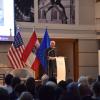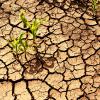
The United Nations Secretary-General, António Guterres, has appointed a new group of ten renowned experts including IIASA Energy, Climate, and Environment Program Director, Keywan Riahi, to support the UN Technology Facilitation Mechanism to bring science into the implementation of the Sustainable Development Goals (SDGs).
 © IIASA
© IIASA
The Technology Facilitation Mechanism was created to support the implementation of the SDGs by facilitating partnerships, collaboration, and sharing of best practices on using science and technology for sustainable development. The mechanism comprises a United Nations Inter-agency Task Team on science, technology, and innovation, currently consisting of 45 entities; an annual multi-stakeholder forum on Science, Technology, and Innovation for the SDGs; and an online platform – the 2030 Connect, which serves as a gateway for information on existing initiatives, mechanisms, and programs.
The newly appointed group will advise on ways of harnessing science, technology, and innovation to accelerate progress on the SDGs. All eminent scientists, researchers, entrepreneurs, and activists, the new members bring a diversity of expertise and experience across various fields of science, technology, innovation, and business. The group will work closely with stakeholder groups, including business, youth and children, and the academic and research community, with the first meeting planned for late May 2021.
“The ten-member group is critical for science and evidence-based SDG implementation and helping to identify frontier technologies and innovations,“ notes Riahi, who has authored 187 journal articles, including 49 in high impact journals like Science, Nature, and the Proceedings of the National Academy of Sciences of the United States of America (PNAS). He also received a European Research Council (ERC) Synergy Grant earlier in 2021, and was ranked first in the recent Reuters list of most influential climate scientists.
The full list of the ten-member group and its terms of reference are available on the UN website.
Further information:
- For further information on the Technology Facilitation Mechanism, please see: https://sdgs.un.org/tfm
- For further information on the 2021 Multi-stakeholder Forum on Science, Technology, and Innovation (STI) for the SDGs, please see: https://sdgs.un.org/tfm/STIForum2021
News

14 June 2024
IIASA Leadership visits Washington DC

05 June 2024
The 2024 State of CDR Report: Scaling up CO2 removal to meet Paris Targets

25 April 2024
